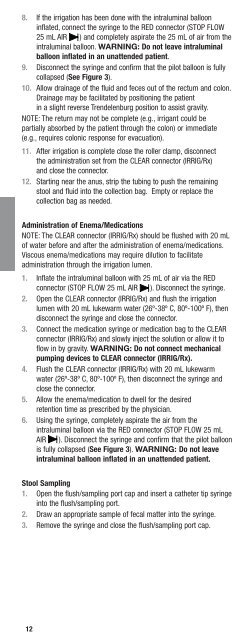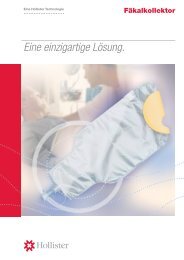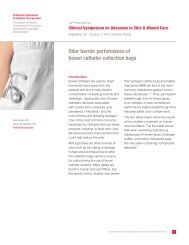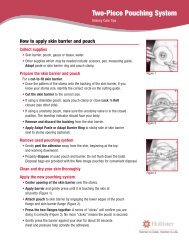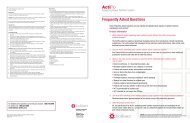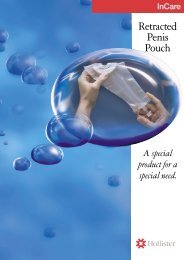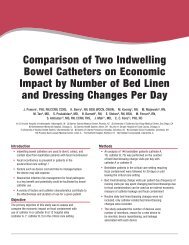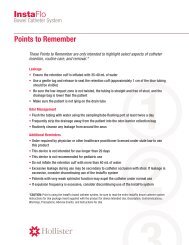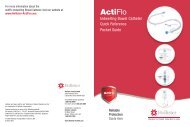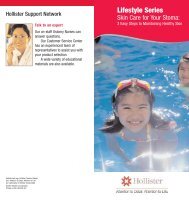Indwelling Bowel Catheter System - Hollister Incorporated
Indwelling Bowel Catheter System - Hollister Incorporated
Indwelling Bowel Catheter System - Hollister Incorporated
- No tags were found...
You also want an ePaper? Increase the reach of your titles
YUMPU automatically turns print PDFs into web optimized ePapers that Google loves.
8. If the irrigation has been done with the intraluminal ballooninflated, connect the syringe to the RED connector (STOP FLOW25 mL AIR ) and completely aspirate the 25 mL of air from theintraluminal balloon. WARNING: Do not leave intraluminalballoon inflated in an unattended patient.9. Disconnect the syringe and confirm that the pilot balloon is fullycollapsed (See Figure 3).10. Allow drainage of the fluid and feces out of the rectum and colon.Drainage may be facilitated by positioning the patientin a slight reverse Trendelenburg position to assist gravity.NOTE: The return may not be complete (e.g., irrigant could bepartially absorbed by the patient through the colon) or immediate(e.g., requires colonic response for evacuation).11. After irrigation is complete close the roller clamp, disconnectthe administration set from the CLEAR connector (IRRIG/Rx)and close the connector.12. Starting near the anus, strip the tubing to push the remainingstool and fluid into the collection bag. Empty or replace thecollection bag as needed.Administration of Enema/MedicationsNOTE: The CLEAR connector (IRRIG/Rx) should be flushed with 20 mLof water before and after the administration of enema/medications.Viscous enema/medications may require dilution to facilitateadministration through the irrigation lumen.1. Inflate the intraluminal balloon with 25 mL of air via the REDconnector (STOP FLOW 25 mL AIR ). Disconnect the syringe.2. Open the CLEAR connector (IRRIG/Rx) and flush the irrigationlumen with 20 mL lukewarm water (26º-38º C, 80º-100º F), thendisconnect the syringe and close the connector.3. Connect the medication syringe or medication bag to the CLEARconnector (IRRIG/Rx) and slowly inject the solution or allow it toflow in by gravity. WARNING: Do not connect mechanicalpumping devices to CLEAR connector (IRRIG/Rx).4. Flush the CLEAR connector (IRRIG/Rx) with 20 mL lukewarmwater (26º-38º C, 80º-100º F), then disconnect the syringe andclose the connector.5. Allow the enema/medication to dwell for the desiredretention time as prescribed by the physician.6. Using the syringe, completely aspirate the air from theintraluminal balloon via the RED connector (STOP FLOW 25 mLAIR ). Disconnect the syringe and confirm that the pilot balloonis fully collapsed (See Figure 3). WARNING: Do not leaveintraluminal balloon inflated in an unattended patient.Stool Sampling1. Open the flush/sampling port cap and insert a catheter tip syringeinto the flush/sampling port.2. Draw an appropriate sample of fecal matter into the syringe.3. Remove the syringe and close the flush/sampling port cap.Maintenance1. Whenever the caregiver changes, verify that the intraluminalballoon is deflated; e.g., verify that the RED connector(STOP FLOW 25 mL Air ) pilot balloon is completely collapsed(See Figure 3). WARNING: Do not leave intraluminalballoon inflated in an unattended patient.2. Frequently verify that the catheter and collection bag arepositioned so that the catheter drain tube is not twisted,kinked or externally compressed.3. Frequently verify that waste is not accumulating in thecatheter drain tube. To remove accumulated waste:• Hold the catheter near the external retention faceplatewith one hand• Constrict the drain tube with the other hand• Strip the tubing toward the collection bag4. Make sure that the patient is not lying on the catheter draintube or catheter connectors. This could cause discomfort orlocalized pressure.5. At least twice daily, flush the inside of the catheter draintube to remove any accumulated fecal matter:• Using a catheter tip syringe, inject water into theflush/sampling port• Strip the tubing toward the collection bag6. Using lukewarm (26º-38º C, 80º-100º F) water or saline, irrigatethe catheter regularly (e.g., every 12 hours) via the CLEARconnector (IRRIG/Rx) as ordered by a physician (See “Irrigation”section page 11).7. Small volumes of mucus or feces may leak onto the perianalregion and can be managed with routine hygiene andabsorbent pads.8. Drain or replace the collection bag as needed. Handle anddispose of in accordance with institutional protocol and universalprecautions for contaminated waste.9. Verify the retention cuff volume at least every 7 days:• Connect the syringe to the BLUE connector(CUFF 35-40 mL H 2 O)• Slowly aspirate all fluid from the retention cuff, thendisconnect the syringe• Verify that the retention cuff is deflated by confirming thatthe BLUE connector (CUFF 35-40 mL H 2 O) pilot balloonis collapsed• Refill the retention cuff via the BLUE connector (CUFF35-40 mL H 2 O) with 35 mL to 40 mL of lukewarm water,then disconnect the syringe• Verify that the BLUE connector (CUFF 35-40 mL H 2 O)pilot balloon indicates that the retention cuff is inflated9. CATHETER REMOVAL1. Inflate the intraluminal balloon with 25 mL of air via theRED connector (STOP FLOW 25 mL Air ). Then, disconnectthe syringe.2. Deflate the retention cuff by connecting the syringe to the BLUEconnector (CUFF 35-40 mL H 2 O) and slowly aspirating allwater. Then, disconnect the syringe.3. Verify that the retention cuff is deflated by confirming that theBLUE connector (CUFF 35-40 mL H 2 O) pilot balloon iscollapsed.1213


